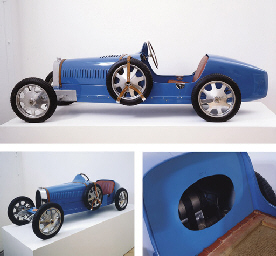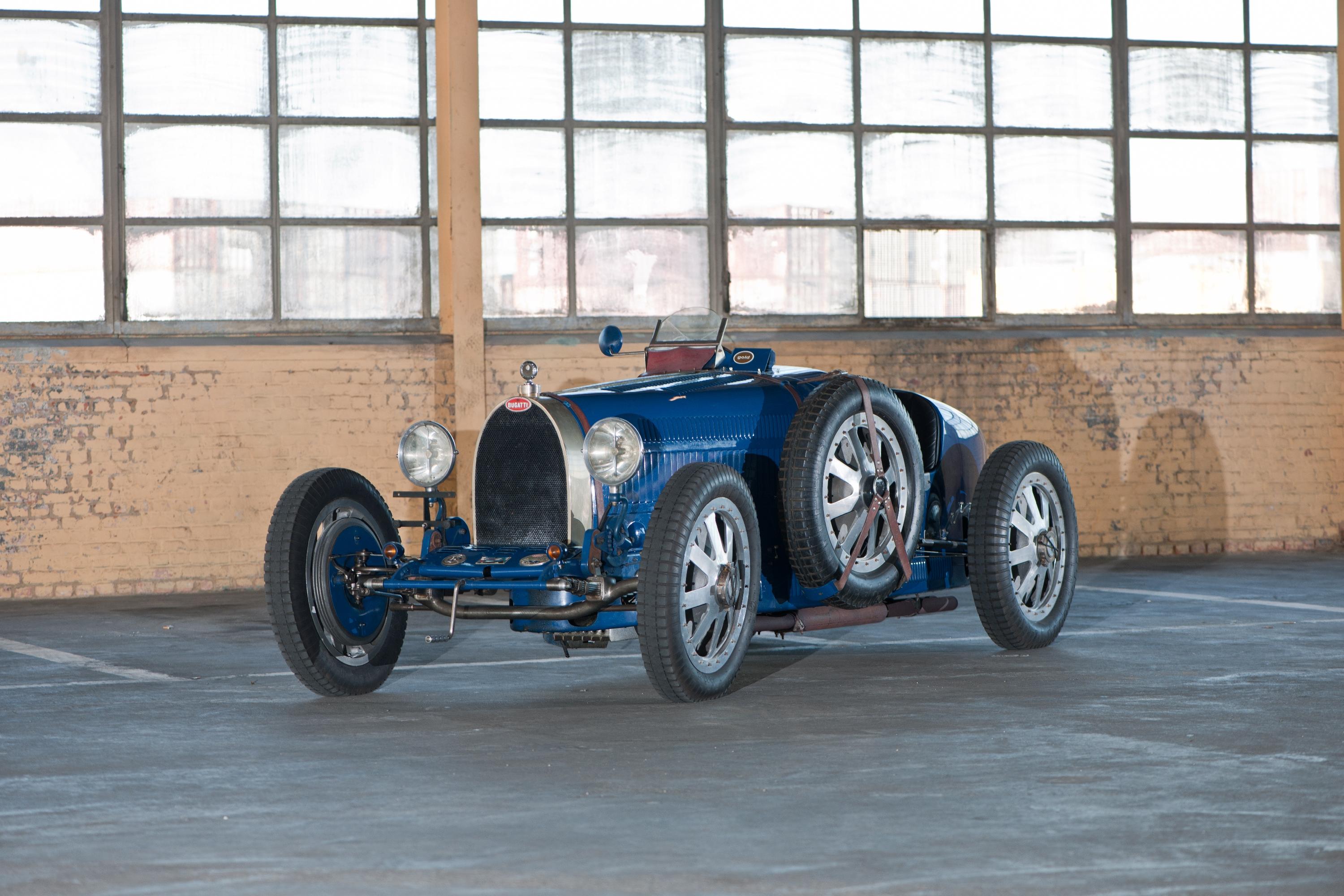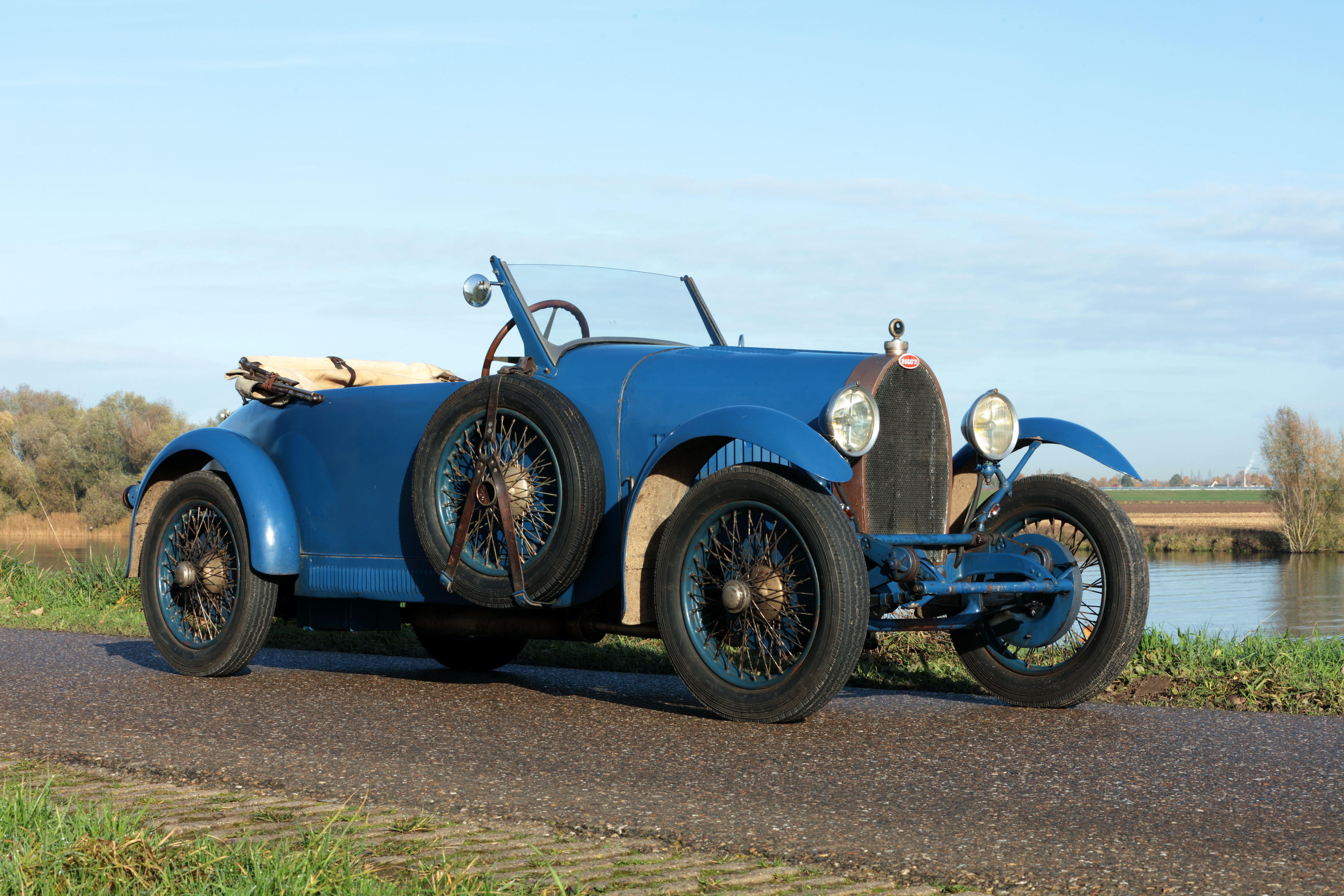1928 BUGATTI TYPE 43 GRAND SPORT EU registered Chassis No. 43219 Engine No. 67 Burgundy with black leather interior Engine: straight-eight in two blocks of four, single overhead camshaft, 24 valves, Zenith 48k carburetor, Roots-type Bugatti supercharger, Bosch magneto ignition, 2,262cc, c120bhp at 5,000rpm; Gearbox: separate four-speed unit with center change; Suspension: beam front axel with semi-elliptic springs, live rear axle with reverse quarter-elliptic springs, Hartford-Repusseau friction shock absorbers front and rear; Brakes: fully compensated cable actuation to front and rear drums integral with the aluminium road wheels. Right hand drive. In the 1920s production two-seater sports cars which could achieve and maintain a genuine maximum speed of 100mph on the road were few and far between. The introduction in early 1927 of the four-seater Type 43 Bugatti Grand Sport with a top speed well in excess of this magic figure caused a sensation in the motoring world. This outstanding performance was achieved by the simple installation of a mildly de-tuned version of the current Type 35B Grand Prix car's supercharged straight-eight engine into the chassis frame of the aborted Type 33 two litre sports car of 1923. Like that of the Type 35, this frame had curved side rails following the plan-view profile of the bodywork but with an almost 25 greater wheelbase capable of accommodating two rows of seats. However, whereas the Type 33 had featured a combined gearbox and rear axle unit similar in concept to that of the 1920 three litre Type 28 prototype, the Type 43 utilised essentially the same separate mid-mounted gearbox as the contemporary touring model Type 38 and 40. The front and rear axle of the Type 43 were likewise virtually identical to those of the Type 38 and later touring models, but fitted with the larger-braked aluminium wheels with which all versions of the supercharged Grand Prix model were shortly to be equipped. Not unnaturally the Grand Sport coachwork mirrored the lines of the widely acclaimed Grand Prix model, with a similarly pointed tail, louvred undertray and aluminium road wheels, and as a result it was generally considered to be equally fine in appearance. However unlike the aluminium-panelled Grand Prix model, it was constructed from steel panels mounted on a timber frame, thereby achieving the greater durability expected of a road car but at the cost of greater weight. Chassis 43219 was initially registered in the factory's name on April 24th 1928 with the registration number 6936 J4. Being a factory owned car there is a possibility that it may have been one of the three official team cars that took part in the 1928 Mille Miglia but this cannot be proven. On October 27th of the same year the car was subsequently sold to André Jameson in Paris, painted blue and wearing a Grand Sport body, which can still be seen today on the old mounts for the bodywork in the chassis. Mr. Jameson, a director of Hottinguer bank and renowned golfer in his day, sold the car on December 11th 1929 to Hackelör-Köbinghoff in Berlin bearing the temporary registration 1647 WW5. The history of 43219 subsequently becomes more vague and it is believed that the car was sold to Czechoslovakia, to J. Zemlicka, as there is a picture of a T43 with registration number S-14727 that cannot be attributed to another car of this model and make at the time. During the war the history of this chassis is unknown but presumably the car was hidden in a safe place as in February of 1947, Antonin Sperlik was at the start of the Winter Rally organised by the National Automobil Club. The next trace of the car is in the late 1950s when it re-appeared in Oppau, Northern Czechoslovakia, with a modified body, possibly by Sodomka. At this time a BMW engine was fitted, however the original engine and gearbox remained alongside the car. In the early 1970s Dr. Lohrer found 43219 and slowly but surely managed to trace the vast majority of original components thr
1928 BUGATTI TYPE 43 GRAND SPORT EU registered Chassis No. 43219 Engine No. 67 Burgundy with black leather interior Engine: straight-eight in two blocks of four, single overhead camshaft, 24 valves, Zenith 48k carburetor, Roots-type Bugatti supercharger, Bosch magneto ignition, 2,262cc, c120bhp at 5,000rpm; Gearbox: separate four-speed unit with center change; Suspension: beam front axel with semi-elliptic springs, live rear axle with reverse quarter-elliptic springs, Hartford-Repusseau friction shock absorbers front and rear; Brakes: fully compensated cable actuation to front and rear drums integral with the aluminium road wheels. Right hand drive. In the 1920s production two-seater sports cars which could achieve and maintain a genuine maximum speed of 100mph on the road were few and far between. The introduction in early 1927 of the four-seater Type 43 Bugatti Grand Sport with a top speed well in excess of this magic figure caused a sensation in the motoring world. This outstanding performance was achieved by the simple installation of a mildly de-tuned version of the current Type 35B Grand Prix car's supercharged straight-eight engine into the chassis frame of the aborted Type 33 two litre sports car of 1923. Like that of the Type 35, this frame had curved side rails following the plan-view profile of the bodywork but with an almost 25 greater wheelbase capable of accommodating two rows of seats. However, whereas the Type 33 had featured a combined gearbox and rear axle unit similar in concept to that of the 1920 three litre Type 28 prototype, the Type 43 utilised essentially the same separate mid-mounted gearbox as the contemporary touring model Type 38 and 40. The front and rear axle of the Type 43 were likewise virtually identical to those of the Type 38 and later touring models, but fitted with the larger-braked aluminium wheels with which all versions of the supercharged Grand Prix model were shortly to be equipped. Not unnaturally the Grand Sport coachwork mirrored the lines of the widely acclaimed Grand Prix model, with a similarly pointed tail, louvred undertray and aluminium road wheels, and as a result it was generally considered to be equally fine in appearance. However unlike the aluminium-panelled Grand Prix model, it was constructed from steel panels mounted on a timber frame, thereby achieving the greater durability expected of a road car but at the cost of greater weight. Chassis 43219 was initially registered in the factory's name on April 24th 1928 with the registration number 6936 J4. Being a factory owned car there is a possibility that it may have been one of the three official team cars that took part in the 1928 Mille Miglia but this cannot be proven. On October 27th of the same year the car was subsequently sold to André Jameson in Paris, painted blue and wearing a Grand Sport body, which can still be seen today on the old mounts for the bodywork in the chassis. Mr. Jameson, a director of Hottinguer bank and renowned golfer in his day, sold the car on December 11th 1929 to Hackelör-Köbinghoff in Berlin bearing the temporary registration 1647 WW5. The history of 43219 subsequently becomes more vague and it is believed that the car was sold to Czechoslovakia, to J. Zemlicka, as there is a picture of a T43 with registration number S-14727 that cannot be attributed to another car of this model and make at the time. During the war the history of this chassis is unknown but presumably the car was hidden in a safe place as in February of 1947, Antonin Sperlik was at the start of the Winter Rally organised by the National Automobil Club. The next trace of the car is in the late 1950s when it re-appeared in Oppau, Northern Czechoslovakia, with a modified body, possibly by Sodomka. At this time a BMW engine was fitted, however the original engine and gearbox remained alongside the car. In the early 1970s Dr. Lohrer found 43219 and slowly but surely managed to trace the vast majority of original components thr















Try LotSearch and its premium features for 7 days - without any costs!
Be notified automatically about new items in upcoming auctions.
Create an alert